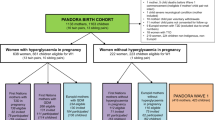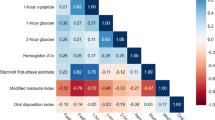Abstract
Background/objective
Previous studies found conflicting results on the association between maternal gestational diabetes mellitus (GDM) and childhood overweight/obesity. This study was to assess the association between maternal GDM and offspring’s adiposity risk from 6 to 8 years of age.
Methods
The present study longitudinally followed 1156 mother-child pairs (578 GDM and 578 non-GDM) at 5.9 ± 1.2 years postpartum and retained 912 mother-child pairs (486 GDM and 426 non-GDM) at 8.3 ± 1.6 years postpartum. Childhood body mass index (BMI), waist circumference, body fat and skinfold were measured using standardized methods.
Results
Compared with the counterparts born to mothers with normal glucose during pregnancy, children born to mothers with GDM during pregnancy had higher mean values of adiposity indicators (waist circumference, body fat, subscapular skinfold and suprailiac skinfold) at 5.9 and 8.3 years of age. There was a positive association of maternal GDM with changes of childhood adiposity indicators from the 5.9-year to 8.3-year visit, and β values were significantly larger than zero: +0.10 (95% CI: 0.02–0.18) for z score of BMI for age, +1.46 (95% CI: 0.70–2.22) cm for waist circumference, +1.78% (95% CI: 1.16%-2.40%) for body fat, +2.40 (95% CI: 1.78–3.01) mm for triceps skinfold, +1.59 (95% CI: 1.10–2.09) mm for subscapular skinfold, and +2.03 (95% CI: 1.35–2.71) mm for suprailiac skinfold, respectively. Maternal GDM was associated with higher risks of childhood overweight/obesity, central obesity, and high body fat (Odd ratios 1.41–1.57 at 5.9 years of age and 1.73–2.03 at 8.3 years of age) compared with the children of mothers without GDM.
Conclusions
Maternal GDM was a risk factor of childhood overweight/obesity at both 5.9 and 8.3 years of age, which was independent from several important confounders including maternal pre-pregnancy BMI, gestational weight gain, children’s birth weight and lifestyle factors. This significant and positive association became stronger with age.
This is a preview of subscription content, access via your institution
Access options
Subscribe to this journal
Receive 12 print issues and online access
$259.00 per year
only $21.58 per issue
Buy this article
- Purchase on Springer Link
- Instant access to full article PDF
Prices may be subject to local taxes which are calculated during checkout


Similar content being viewed by others
Data availability
The datasets used and/or analyzed during the current study are available from the corresponding author on reasonable request.
References
Hu K, Staiano AE. Trends in obesity prevalence among children and adolescents aged 2 to 19 years in the US From 2011 to 2020. JAMA Pediatr. 2022;176:1037–9.
Collaboration NCDRF. Worldwide trends in body-mass index, underweight, overweight, and obesity from 1975 to 2016: a pooled analysis of 2416 population-based measurement studies in 128.9 million children, adolescents, and adults. Lancet. 2017;390:2627–42.
Weiss R, Kaufman FR. Metabolic complications of childhood obesity: identifying and mitigating the risk. Diab Care. 2008;31:S310–6.
Singh AS, Mulder C, Twisk JW, van Mechelen W, Chinapaw MJ. Tracking of childhood overweight into adulthood: a systematic review of the literature. Obesity Rev Off J Int Assoc Study Obes. 2008;9:474–88.
Wang H, Li N, Chivese T, Werfalli M, Sun H, Yuen L, et al. IDF Diabetes Atlas: Estimation of Global and Regional Gestational Diabetes Mellitus Prevalence for 2021 by International Association of Diabetes in Pregnancy Study Group’s Criteria. Diab Res Clin Pract. 2022;183:109050.
Zhou T, Du S, Sun D, Li X, Heianza Y, Hu G, et al. Prevalence and trends in gestational diabetes mellitus among women in the United States, 2006-2017: a population-based study. Front Endocrinol (Lausanne). 2022;13:868094.
Zhao P, Liu E, Qiao Y, Katzmarzyk PT, Chaput JP, Fogelholm M, et al. Maternal gestational diabetes and childhood obesity at age 9-11: results of a multinational study. Diabetologia. 2016;59:2339–48.
Wang J, Wang L, Liu H, Zhang S, Leng J, Li W, et al. Maternal gestational diabetes and different indicators of childhood obesity - a large study. Endocr Connect. 2018;7:1464–71.
Wang J, Pan L, Liu EQ, Liu HY, Liu J, Wang ST, et al. Gestational diabetes and offspring’s growth from birth to 6 years old. Int J Obesity. 2019;43:663–72.
Patro Golab B, Santos S, Voerman E, Lawlor DA, Jaddoe VWV, Gaillard R, et al. Influence of maternal obesity on the association between common pregnancy complications and risk of childhood obesity: an individual participant data meta-analysis. Lancet Child Adolesc Health. 2018;2:812–21.
Kawasaki M, Arata N, Miyazaki C, Mori R, Kikuchi T, Ogawa Y, et al. Obesity and abnormal glucose tolerance in offspring of diabetic mothers: A systematic review and meta-analysis. PloS one. 2018;13:e0190676.
Gao M, Cao S, Li N, Liu J, Lyu Y, Li J, et al. Risks of overweight in the offspring of women with gestational diabetes at different developmental stages: A meta-analysis with more than half a million offspring. Obes Rev: Offic J Int Assoc Study Obes. 2022;23:e13395.
Wells JC. Toward body composition reference data for infants, children, and adolescents. Adv Nutr. 2014;5:320S–9S.
Dixit S, Gular K, Gautam AP, Reddy RS, Ahmad I, Tedla JS et al. Association between Handgrip Strength, Skinfold Thickness, and Trunk Strength among University Students. Diagnostics (Basel) 2023; 13.
Hu G, Tian H, Zhang F, Liu H, Zhang C, Zhang S, et al. Tianjin gestational diabetes mellitus prevention program: study design, methods, and 1-year interim report on the feasibility of lifestyle intervention program. Diab Res Clin Pract. 2012;98:508–17.
Liu H, Wang L, Zhang S, Leng J, Li N, Li W, et al. One-year weight losses in the Tianjin Gestational Diabetes Mellitus Prevention Programme: A randomized clinical trial. Diabetes Obes Metab. 2018;20:1246–55.
Li W, Zhang S, Liu H, Wang L, Zhang C, Leng J, et al. Different associations of diabetes with beta-cell dysfunction and insulin resistance among obese and nonobese Chinese women with prior gestational diabetes mellitus. Diabetes Care. 2014;37:2533–9.
WHO. WHO Consultation: Definition, Diagnosis and Classification of Diabetes mellitus and Its Complications. Part 1: Diagnosis and Classification of Diabetes mellitus. World Health Organisation; Geneva, Switzerland: 1999.
Li YP, He YN, Zhai FY, Yang XG, Hu XQ. WH Z et al. Comparison of assessment of food intakes by using 3 dietary survey methods. Chin J Prev Med. 2006;40:273–79.
Group WHOMGRS. WHO Child Growth Standards based on length/height, weight and age. Acta Paediatr Suppl. 2006;450:76–85.
de Onis M, Onyango AW, Borghi E, Siyam A, Nishida C, Siekmann J. Development of a WHO growth reference for school-aged children and adolescents. Bull World Health Organ. 2007;85:660–7.
Fernandez JR, Redden DT, Pietrobelli A, Allison DB. Waist circumference percentiles in nationally representative samples of African-American, European-American, and Mexican-American children and adolescents. J Ped. 2004;145:439–44.
Laurson KR, Eisenmann JC, Welk GJ. Body fat percentile curves for U.S. children and adolescents. Am J Prev Med. 2011;41:S87–92.
Do CB, Batzoglou S. What is the expectation maximization algorithm? Nat Biotechnol. 2008;26:897–9.
Pitchika A, Vehik K, Hummel S, Norris JM, Uusitalo UM, Yang J, et al. Associations of maternal diabetes during pregnancy with overweight in offspring: results from the prospective TEDDY study. Obesity (Silver Spring). 2018;26:1457–66.
Lu J, Gu Y, Wang L, Li W, Zhang S, Liu H, et al. Glucose metabolism among obese and non-obese children of mothers with gestational diabetes. BMJ Open Diab Res Care. 2020;8.
Slupecka-Ziemilska M, Wychowanski P, Puzianowska-Kuznicka M. Gestational diabetes mellitus affects offspring’s epigenome. is there a way to reduce the negative consequences? Nutrients. 2020;12.
Li W, Wang L, Li N, Liu H, Zhang S, Hu G, et al. Maternal prepregnancy BMI and glucose level at 24-28 gestational weeks on offspring’s overweight status within 3 years of age. BioMed Res Int. 2017;2017:7607210.
Li N, Liu E, Guo J, Pan L, Li B, Wang P, et al. Maternal prepregnancy body mass index and gestational weight gain on offspring overweight in early infancy. PloS one. 2013;8:e77809.
Metzger BE, Gabbe SG, Persson B, Buchanan TA, Catalano PA, Damm P, et al. International association of diabetes and pregnancy study groups recommendations on the diagnosis and classification of hyperglycemia in pregnancy. Diab Care. 2010;33:676–82.
Dietz P, Bombard J, Mulready-Ward C, Gauthier J, Sackoff J, Brozicevic P, et al. Validation of self-reported maternal and infant health indicators in the Pregnancy Risk Assessment Monitoring System. Mat Child Health J. 2014;18:2489–98.
Funding
This study was supported by grants from the European Foundation for the Study of Diabetes (EFSD)/Chinese Diabetes Society (CDS)/Lilly programme for Collaborative Research between China and Europe, and the National Institute of Diabetes and Digestive and Kidney Diseases (R01DK100790). Dr. Hu was partially supported by the grant from the National Institute of Diabetes and Digestive and Kidney Diseases (R01DK132011), the National Institute of General Medical Sciences (U54GM104940), and the Public University Partnership Program at the Louisiana Department of Health, Bureau of Health Services Financing.
Author information
Authors and Affiliations
Contributions
W.L. and G.H. conceived and designed the study. L.W., H.L., S.Z., W.L. and J.L. performed the fieldwork and collected data. W.L. and G.H. performed the statistical analysis, interpreted the data, and drafted the article. X.Y., Z.Y. and A.S. provided major comments to the manuscript. All authors contributed to the article and approved the submitted version. W.L. and G.H. were responsible for the integrity of the work as a whole.
Corresponding authors
Ethics declarations
Competing interests
The authors declare no competing interests.
Additional information
Publisher’s note Springer Nature remains neutral with regard to jurisdictional claims in published maps and institutional affiliations.
Supplementary information
Rights and permissions
Springer Nature or its licensor (e.g. a society or other partner) holds exclusive rights to this article under a publishing agreement with the author(s) or other rightsholder(s); author self-archiving of the accepted manuscript version of this article is solely governed by the terms of such publishing agreement and applicable law.
About this article
Cite this article
Li, W., Wang, L., Liu, H. et al. Maternal gestational diabetes and childhood adiposity risk from 6 to 8 years of age. Int J Obes 48, 414–422 (2024). https://doi.org/10.1038/s41366-023-01441-y
Received:
Revised:
Accepted:
Published:
Issue Date:
DOI: https://doi.org/10.1038/s41366-023-01441-y



